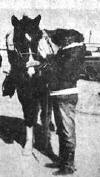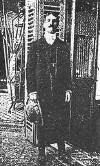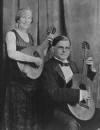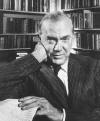Prince Galatzin of Russia made a 12,000 mile ride through Russia, Turkestan and Tibet. A descendant of one Russia’s noblest families, according to an interview granted to the Los Angeles Times on November 23, 1893, Galatzin had just arrived by ship in San Francisco, after having completed an equestrian journey of tremendous proportions.
Galatzin set off from St. Petersburg in May, 1890, after having been commissioned by the Czar to undertake a scientific and diplomatic mission, so as to collect specimens of minerals and plants, as well as to make barometric observations. The prince travelled with a mounted escort provided by the Russian ruler.
“On reaching the Tibetan highlands we could barely breathe. I soon found that it was highly dangerous to sleep on the ground, not because of the cold but because of the possibility of the heart ceasing to beat. Though one might not notice at first, his lungs soon grew too cramped to afford free breathing and the sleeper would grow black in the face, while his heart would flutter like a wounded bird. Several of my men came near losing their lives, so to obviate the great danger of dying while trying to gain a little rest, we were forced to sleep in a sitting posture,” Galatzin recalled.
As they proceeded, the lack of oxygen caused the Russians to have delusions.
“The thin air caused us to move very slowly and become the victims of strange hallucinations. One day some of my men said that they had seen two queer men in white who said they were ghosts. All of us felt very light-headed and strange. Our hearts fluttered as though they might suddenly stop and we were weak as though we were recovering from a serious sickness. We found we must eat no meat nor drink spirits, as these increased the beating of our hearts. Sugar was good but a single cup of coffee in that thin air could kill a man.”
Though he had survived the journey, the forty-six-year-old nobleman was reported to be in frail health.
Thora Gauthier was one of the three “Rangerettes” who rode from Erie, Pennsylvania to Banning, California in 1962/1963.

While the annals of The Long Riders’ Guild are full of daring tales written by intrepid men and women, few equestrian explorers can match the James Bond-like escapades of the Scottish Long Rider, Parker Gillmore.
Gillmore was already a seasoned world traveller, big game hunter and prolific author whose journeys had taken him to dangerous parts of North America and Africa, when the British government offered to send him on a secret mission for Her Majesty, Queen Victoria.
The date was April, 1879 and the job was simple.
Gillmore was to mount up at Cape Town, South Africa, ride more than a thousand miles alone into the heart of the African continent, whereupon he was to negotiate with local native rulers, urging them to allow their warriors to become part of the English army. When that bit of mounted diplomacy was accomplished, the amateur ambassador was to ride back and report on his success.
Mind you, there was one bit of bother.
Forty thousand warriors in the deadly Zulu army, under the command of their wily leader, King Cethshwayo, had gone on the war path against the English red coats. As if that wasn’t bad enough, the overly optimistic British force which initially took the field suffered a deadly defeat while camped at Isandlwana, where nearly every soldier was killed. Thus Africa was ablaze in what amounted to a genocidal gang war when Parker Gillmore was asked to ride into this blazing cauldron of danger and deceit.
The resultant equestrian journey became a litany of courage and suffering.
In his book, A Ride through Hostile Africa, Gillmore recounted how he drove away lions intent on eating his horses, crossed the edge of the deadly Kalahari desert, endured starvation, went without water and became lost on the trackless veldt, before he even managed to find the tribal chiefs he had been sent to negotiate with. One such meeting resulted in the chief informing the uninvited Gillmore that he was prepared to have a hundred of his nearby warriors spear the impudent Scottish Long Rider to death. At which point the cool Gillmore pointed both his pistols at the chief and advised the local regent that if a spear moved the king would proceed the equestrian explorer to the happy hunting ground.
Thus, with little to show on the diplomatic front, Gillmore turned his weary horses, Bobby and Tommy, towards the safety of faraway Cape Town. Yet his troubles were far from over. Raging rivers blocked their path and Gillmore was tormented by an “African fever” so severe that at one point he passed out under a tree for nearly twenty-four hours. Luckily, when he awoke, the Long Rider found his horses hovering overhead, as anxious as he to escape from the many perils surrounding them.
At last, after a ride that should have made him a hero, the near-dead Gillmore rode into civilization, where he was promptly informed that the Zulu war was over, hence his services were no longer required, and that during his absence his beloved wife of twenty-five years had died and been buried.
Years later the famous English author, H. Rider Haggard, penned several novels about an intrepid big game hunter named Allan Quatermain, a fictional hero whose adventures in turn helped inspire the creation of Indiana Jones. Yet few now remember the real life Long Rider, Parker Gillmore, whose equestrian journey across African rivaled any fictional account either on the page or the silver screen.
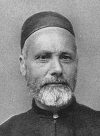

While it is commonly known that George Washington defeated the British and went on to become the first president of the United States, what is often overlooked is that a Long Rider named Christopher Gist (1706–1759) twice saved the future statesman’s life.
Christopher Gist was a skilful scout and surveyor who was chosen to make the first exploration of the Ohio Country, that giant area which was to later become the states of Ohio, eastern Indiana, western Pennsylvania, and north-western West Virginia, USA.
The directors of the newly formed Ohio Company authorized Gist to survey the Ohio River from its headwaters near Shannopin's Town, Pennsylvania (modern-day Pittsburgh), to what is now Louisville, Kentucky.
Once he had saddled up and set off, Gist encountered problems which any modern Long Rider would recognize, including the need to put bells on his horses in case they ran away. But in other ways Gist’s exploration of the Ohio country revealed what a pristine wilderness North America was. At one point he had to cut a two mile path through a seemingly endless laurel thicket.
Nor was he able to obtain food for himself or his horses with today’s current ease. Thanks to his friendship with the Native Americans, Gist was able to procure corn and salt to augment his horse’s diet. But feeding himself was a bit more complicated. He wrote in his diary, “This afternoon as we wanted provisions I killed a bear.”
By the time Gist completed the survey, he had ridden as far as the site of present day Frankfort, Kentucky. Even though Daniel Boone is generally given credit for opening Kentucky to white settlement, Gist’s journey preceded Boone’s by more than fifteen years.
Having established a reputation as a dependable wilderness scout, Gist was then chosen by a young officer named George Washington to accompany him on a delicate diplomatic mission into that part of America held by opposing French military forces. It was while travelling together that Gist twice saved Washington’s life.
The “soldier-author” was how Willard Glazier billed himself. A penniless schoolboy at the beginning of the American Civil War, Glazier enlisted in a cavalry unit of the Union Army of the Potomac and was soon captured by Confederate troops. After a daring escape, he was recaptured, only to escape a second time, before finally reaching the Union lines again. At the conclusion of the conflict Glazier wrote a book describing his wartime experiences. When every New York publisher rejected him, the young cavalryman self-published his work, hoping to make back his costs plus a hundred dollars profit. Instead, to his delight, the book took off like wildfire, selling 400,000 copies. With the $75,000 profit realized from his efforts, Glazier determined to ride “from Ocean to Ocean.” Leaving New York state in 1875 on his horse, Paul Revere, the former trooper set out to see the mighty Pacific, many miles and many unexpected adventures away.
Ocean to Ocean on Horseback is Glazier at his best, complete with every sort of mounted adventure, and includes an account of how he was kidnapped by Arapahoe Indians.
Though few today remember either their journeys or their books, Cora and Jan Gordon were top notch English travel writers of the Jazz Age whose exploits took them to a variety of exotic locales. The couple's adventures began when they worked with the Red Cross during the First World War. Having narrowly escaped being slaughtered in that conflict, after the war ended they lived in Paris where they witnessed the Bohemian events of the 1920s. A remarkable couple, the Gordons wrote twenty-six books on their travels through England, Ireland, France, Spain, Albania, Serbia, Montenegro, Sweden, Portugal and the USA. In 1925 they explored Albania on horseback, a journey which resulted in the publication of their book, “Two Vagabonds in Albania.” It was during this journey that the Gordons, armed with nothing more than their sense of humour, Jan's guitar and Cora's lute, met “gentle assassins” and a host of other memorable figures on their ride through Albania.


